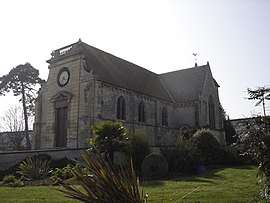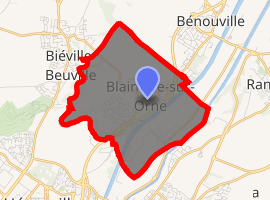Blainville-sur-Orne
Blainville-sur-Orne is a commune in the Calvados department in the Normandy region in northwestern France.
Blainville-sur-Orne | |
|---|---|
 The church in Blainville-sur-Orne | |
 Coat of arms | |
Location of Blainville-sur-Orne 
| |
 Blainville-sur-Orne  Blainville-sur-Orne | |
| Coordinates: 49°13′47″N 0°17′56″W | |
| Country | France |
| Region | Normandy |
| Department | Calvados |
| Arrondissement | Caen |
| Canton | Ouistreham |
| Intercommunality | Caen la Mer |
| Government | |
| • Mayor (2014–2020) | Daniel Françoise |
| Area 1 | 7.11 km2 (2.75 sq mi) |
| Population (2017-01-01)[1] | 5,801 |
| • Density | 820/km2 (2,100/sq mi) |
| Time zone | UTC+01:00 (CET) |
| • Summer (DST) | UTC+02:00 (CEST) |
| INSEE/Postal code | 14076 /14550 |
| Elevation | 0–36 m (0–118 ft) (avg. 25 m or 82 ft) |
| 1 French Land Register data, which excludes lakes, ponds, glaciers > 1 km2 (0.386 sq mi or 247 acres) and river estuaries. | |
Blainville-sur-Orne is on the west side of the Canal de Caen à la Mer, just south of Bénouville and the famous Pegasus Bridge of D-Day fame. The town is also home to a Renault Trucks (formerly Saviem) manufacturing plant. The plant is across the canal to the southeast, between the canal and the Orne River. Just across the river from the plant is the commune of Colombelles. Directly across the canal from Blainville-sur-Orne is the fourth commercial French port for the importation of exotic wood, generally coming from the Gulf of Guinea. The port also exports cereals that are produced in the area and has a silo capacity of 33,000 tons.
Geography
- 7 km (4.3 mi) north of Caen
- 7 km (4.3 mi) south of the English Channel
Population
| Historical population | ||
|---|---|---|
| Year | Pop. | ±% |
| 1793 | 210 | — |
| 1800 | 299 | +42.4% |
| 1806 | 325 | +8.7% |
| 1821 | 382 | +17.5% |
| 1831 | 351 | −8.1% |
| 1836 | 359 | +2.3% |
| 1841 | 353 | −1.7% |
| 1846 | 389 | +10.2% |
| 1851 | 357 | −8.2% |
| 1856 | 362 | +1.4% |
| 1861 | 381 | +5.2% |
| 1866 | 388 | +1.8% |
| 1872 | 351 | −9.5% |
| 1876 | 350 | −0.3% |
| 1881 | 307 | −12.3% |
| 1886 | 297 | −3.3% |
| 1891 | 282 | −5.1% |
| 1896 | 245 | −13.1% |
| 1901 | 235 | −4.1% |
| 1906 | 239 | +1.7% |
| 1911 | 231 | −3.3% |
| 1921 | 960 | +315.6% |
| 1926 | 1,189 | +23.9% |
| 1931 | 1,206 | +1.4% |
| 1936 | 579 | −52.0% |
| 1946 | 1,573 | +171.7% |
| 1954 | 2,079 | +32.2% |
| 1962 | 2,119 | +1.9% |
| 1968 | 2,735 | +29.1% |
| 1975 | 2,519 | −7.9% |
| 1982 | 4,390 | +74.3% |
| 1990 | 4,341 | −1.1% |
| 1999 | 4,387 | +1.1% |
| 2008 | 6,002 | +36.8% |
Twin towns
Blainville-sur-Orne is twinned with:


See also
- Blainville, Quebec - a suburb of Montreal
- Communes of the Calvados department
References
- "Populations légales 2017". INSEE. Retrieved 6 January 2020.
| Wikimedia Commons has media related to Blainville-sur-Orne. |